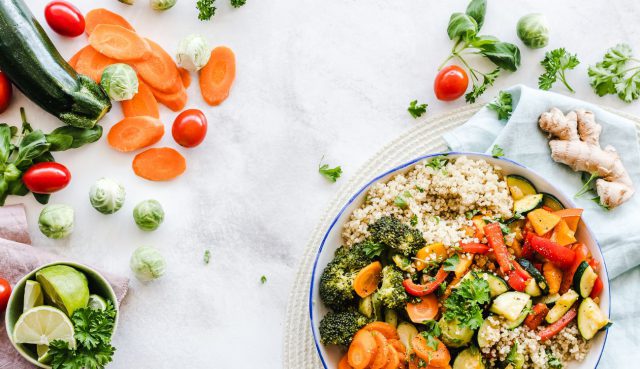March is nutrition Month!
A diet rich in vegetables and fruits can lower blood pressure, reduce the risk of heart disease and stroke, prevent some types of cancer, lower risk of eye and digestive problems, and have a positive effect upon blood sugar, which can help keep appetite in check.
Here are 5 ways to increase your vegetable intake into your day.
1. Make veggie-based soups.
Soups are an excellent way to consume multiple servings of vegetables at once. You can make veggies the “base” by pureeing them and adding spices.
Furthermore, it’s simple to cook veggies into broth- or cream-based soups. Adding even a small number of extra veggies, such as broccoli, to soups is a great way to increase your intake of fiber, vitamins, and minerals.
2. Experiment with veggie noodles.
Veggie noodles are easy to make, and a great way to get more veggies in your eating plan. They’re also an excellent low carb substitute for high carb foods, such as pasta.
They’re made by inserting vegetables into a spiralizer, which processes them into noodle-like shapes. You can also:
- shred them
- slice them with a mandoline
- cut them up as you please
You can use a spiralizer for almost any type of vegetable. They’re commonly used for zucchini, carrots, spaghetti squash, and sweet potatoes, all of which come packed with extra nutrients.
Once the “noodles” are made, they can be consumed just like pasta and combined with sauces, other vegetables, or meat.
3. Add veggies to sauces, smoothies, casseroles.
Adding extra vegetables to your sauces and dressings is a sneaky way to increase your veggie intake, especially if you have picky kids.
While you’re cooking sauces, such as marinara sauce, simply add some veggies and herbs of your choice to the mix, such as chopped onions, carrots, bell peppers, and leafy greens like spinach. Pureeing roasted root vegetables can make for rich sauces with an Alfredo-like feel. Think carrots, sweet potatoes, squash, turnips, or beets. Try making pesto with roasted beets for the most vibrant dish ever.
4. Make a cauliflower pizza crust.
Cauliflower is extremely versatile. You can rice it, roast it, stick it in a stew, puree it for silky goodness, and make it into a pizza crust.
Replacing a regular, flour-based pizza crust with a cauliflower crust is as easy as combining finely chopped and drained cauliflower with eggs, almond flour, and some seasonings.
You can then add your own toppings, such as fresh veggies, tomato sauce, and cheese. A cup (100 grams) of cauliflower contains only about 5 grams of carbs and 26 calories, in addition to lots of fiber, vitamins, minerals, and antioxidants.
5. Cook a veggie omelet.
Omelets are an easy and versatile way to add veggies into your meal plan. Plus, eggs add lots of good nutrients, too. Cook up some beaten eggs with a small amount of butter or oil in a pan, and then fold them around a filling that often includes cheese, meat, vegetables, or a combination of the three.
The bottom line
There are so many ways to add vegetables to everyday food items. Some can sneak right into recipes without a lot of drama (like spinach) and some add color and flavor in ways you’d never expect (like beets and sweet potatoes).
Adding to a dish is great, but sometimes veggies can become the star as your sandwich bun or rice.
Tip: If you don’t like a certain vegetable that you’ve only tried boiled, give roasting a try. So many people who hate boiled Brussels sprouts end up loving roasted or sauteed sprouts.
By making veggies a regular part of your eating habits, you’ll significantly increase your intake of fiber, nutrients, and antioxidants.












